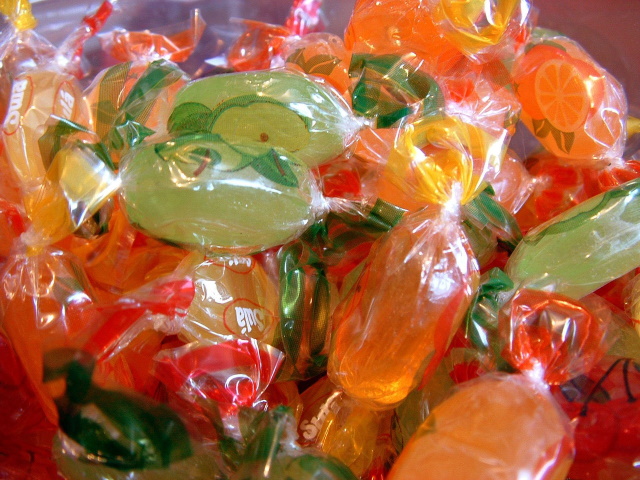
Most of us never really grow out of our love for candy. Sure, we tell ourselves we do, but there's a reason candy-making videos have become all the rage in online spaces like YouTube and Facebook. Adults still love the sweet stuff; it's as simple as that.
Further proof of our confectionery devotion is the fact that the candy industry in the U.S. alone is a whopping $35 billion/year business. You and I both know, we're not giving all those bonbons to our kids. We're sneaking those sweets when no one's looking.
If you've ever consciously tried to cut down on sugar while raising children, you've noticed that there is always a reason to have candy in the house. Sometimes it's a post-Easter stash calling your name out from the back of a cupboard. Other times you're drawn by the subtle smell of candy corn at the bottom of your kid's trick or treat bag. Maybe, it's just leftover candy canes from Old St. Nick. Heck, even if you don't give your kids candy for these holidays, someone else is bound to do it! Candy is simply everywhere.
It's no wonder candy rakes in so much dough.
As you might have guessed, most of those revenue dollars are being made by companies that manufacture candy bars. Chocolate is hands down, the biggest seller. Us North Americans really love the brown stuff. Gum, gummies and sugar-free options also top the revenue charts in the confectionery industry. Hard candy holds its own, though, raking in a cool $591 million per year in the U.S.
The most popular brands of hard candy are Jolly Ranchers and Werther's Original, neither of which are all that surprising. It seems like Werther's occupy every candy dish in the continental U.S. (and always disappear fast).
One of the smallest market shares in the confectionery industry belongs to softer, chewier candy such as taffy. That's not to say Americans still don't love the stuff, buying a whopping $210 million worth of it every year.
What is the difference between hard candy and pulled candy?
The answers to these questions are simple.
Hard candy is flavored sugar melted down into a syrup and then allowed to cool. Often the candy is cooled in molds to take a familiar shape. The resulting product is hard, brittle and often shiny, like glass. If you drop it, it's going to smash.
To make candy of this sort, you need a high concentration of sugar in the syrup. 99% to be exact. It must be boiled to 160 °C (320 °F) to get that classic glass-like brittleness.
Taffy, on the other hand, starts as a syrup with a lower concentration of sugar, about 95% and it is boiled to a lower temperature than hard candy. Taffy is cooked to a temperature range of around 132 to 143 °C (270 to 289 °F).
Taffy is often pulled, as well, using a candy hook. When the syrup mixture reaches the necessary temperature, it's poured out on a marble countertop to cool as it is far too hot to handle right out of the kettle. Once it has cooled slightly, the candy maker will sling it over a candy pulling hook, stretch it, fold it back over onto itself and repeat the process. The purpose of this method is to incorporate tiny air bubbles into the sweet mixture, which gives the resulting product an opaque, finished look and can create a chewier, softer end product.
The final texture, however, will depend on your candy concentration and the temperature the mixture reached in the kettle.
You can, of course, pull your candy concoction by hand with a relatively cheap candy pulling hook that will run you a couple hundred bucks. Or, you can purchase a candy pulling machine for a few thousand dollars and save yourself some time and energy. For larger batches of candy, a machine might be your best bet.
The newest trend in the candy biz is craft candy. Like craft beer or craft soda, craft candy is made by small, mom n' pop shops popping up across the U.S. that are turning back to old ways and highlighting local ingredients. They're using traditional methods and their own hands to craft some of the tastiest treats around. These are the folks who tend to make the mesmerizing candy-pulling videos that pop up on your Facebook news feed. Videos like this one:
You'll notice these candy makers are doing everything by hand, adding to the appeal of the finished product.
In a more industrial, large-batch setting, machines are used to incorporate air into the candy:
In both videos, you can see that as the candy is pulled, the more opaque the color becomes.
The difference between hard candy and pulled candy perfectly illustrates how the same ingredients can produce an entirely different experience depending on how they are prepared. It's all just sugar, water, color and flavor. Hard candies are cooked to a higher temperature and have a higher sugar concentration, while chewier candies are cooked to a slightly lower temperature and have a minutely smaller sugar concentration. One will crack when you bite down on it. The other is going to give way to the pressure of your teeth.
Some people opt for the hard version of their favorite treats over the soft because the softer, chewier bites are notorious for getting stuck in your teeth, ripping out fillings and destroying any orthodontic appliances they might have occupying their mouths.
Whether you prefer your candy hard or chewy, though, you're going to need to brush your teeth.
So, which sort of candy do you prefer? Are you a hard candy lover or do you prefer a chewier sensation while satisfying your sweet tooth? Me, I am more of a gummy lover than anything, but gummies are a whole other blog post.
Check out the kind of Candy Equipment available on Bid on Equipment right now!